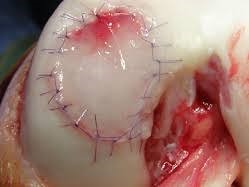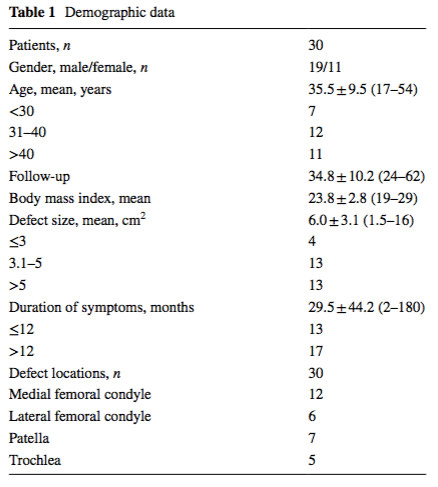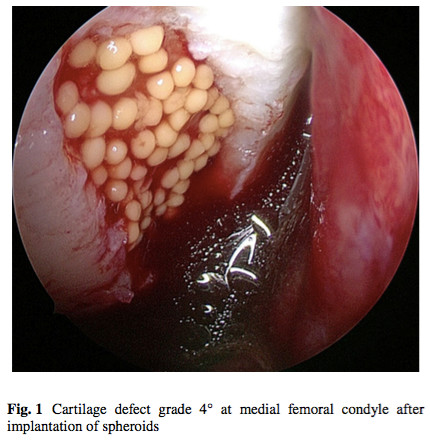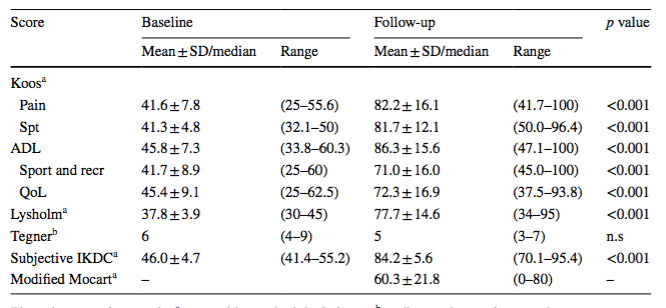
Introduction
Le cartilage articulaire est un tissu hautement spécialisé, agissant en qualité d’abaisseur de friction, du supporteur de charge et de surface de lubrification. Il permet de répartir les forces de cisaillement, de compression ou de tension au niveau de l’os sous chondral. Néanmoins, dû à une quasi absence de vascularisation, le processus de cicatrisation du cartilage hyalin fait défaut. Les lésions du cartilage peuvent être causées par des traumatismes, des prédispositions génétiques, un défaut de répartition de charge, une instabilité ligamentaire, la perte d’un ménisque et aussi à l’âge.
De nombreuses techniques de réparation du cartilage ont été employées, principalement accèes sur l’abrasion de la moelle de l’os sous chondral. Mais le fibrocartilage résultant de ces manipulations est inférieur dans ses propriétés biomécaniques comparé au cartilage hyalin, avec des résultats sur le long terme moindre, menant à une arthrose progressive.
Les premières techniques d’implantation autologue de chondrocyte, qui voient le jour en 1994, ont confirmé la possibilité de produire un cartilage mécaniquement et fonctionnellement stable. Malgré les résultats cliniques prometteurs, ces techniques nécessitent néanmoins l’utilisation d’échafaud, et une arthrotomie du genou pour l’implantation du cartilage.
Récemment, une nouvelle technique prometteuse emploie des sphères en 3 dimensions de chondrocyte autologue (ACT3D), issu de l’ingénierie in vivo. En utilisant cette procédure, les chondrocytes autologues peuvent être appliqués sous arthroscopie, dans n’importe quel endroit du genou, sans utilisation d’échafaud, du fait que les chondrosphère adhère à l’os sous chondral grâce aux forces de tension de surface.
Objectif
L’objectif de l’étude est d’analyser les données cliniques et la régénération du cartilage après une implantation de chondrocyte autologue (ICA) sous arthroscopie, en utilisant de chondrosphère (ACT3D) pour le traitement de lésions complète de cartilage articulaire au niveau du genou.
Méthode
La population de cette étude est constituée de 30 personnes, toute traitées par ICA arthroscopique. Les données relatives aux sujets sont regroupées dans le tableau 1.

Les déficiences cartilagineuses ont été retrouvées au niveau des condyles fémorales (n=18), de la trochlée (n=7), et de la patella (n=5).
En raison d’un état de différenciation cellulaire avancé, les chondrocytes dans les sphères (figure 1) synthétisent des protéines spécifiques au cartilage et des composants matriciels. L’adhésion des sphères avec le cartilage adjacent et l’os est possible dans les 20 minutes, sans aucune fixation complémentaire.
- Le suivi des patients a consisté en une évaluation clinique par évaluation de scores subjectifs. La satisfaction du patient a été évalué grâce à une échelle visuelle analogique.
- Pour contrôler la qualité de régénération du cartilage, un suivi IRM du genou opéré et du genou controlatéral sain a été mis en place. Le score MOCART a été évalué en aveugle par 3 radiologistes indépendants.
En raison d’un état de différenciation cellulaire avancé, les chondrocytes dans les sphères (figure 1) synthétisent des protéines spécifiques au cartilage et des composants matriciels. L’adhésion des sphères avec le cartilage adjacent et l’os est possible dans les 20 minutes, sans aucune fixation complémentaire.

La réhabilitation post opératoire consiste à supporter pendant 6 semaines une charge partielle de 10kg, avec une amplitude complète au bout de 6 semaines. Le retour aux sports avec beaucoup d’impaction n’est pas autorisé avant le 12-15e mois après la chirurgie, en fonction du type de sport, et de la lésion cartilagineuse traitée par ICA.
A un temps de suivi moyen de 3 ans (+/- 10,2 mois), 26 patients sur les 30 (86,6%) ont été subjectivement hautement satisfaits par les résultats chirurgicaux et assurent qu’ils recommenceraient la même procédure si nécessaire.
Résultat
A un temps de suivi moyen de 3 ans (+/- 10,2 mois), 26 patients sur les 30 (86,6%) ont été subjectivement hautement satisfaits par les résultats chirurgicaux et assurent qu’ils recommenceraient la même procédure si nécessaire.
- L’analyse des scores cliniques montre que, mis à part le Tegner score, tout les scores d’évaluation clinique sont améliorés de façon significative (P<0.001). L’ensemble des résultats des scores est regroupé dans le tableau suivant :

- La moyenne du score MOCART modifié était de 60.0 +/- 21.8 points (0-80). 18 patients (60%) ont eu un score supérieur à 60 points. Trois patient (10%) ont eu un score MOCART de 0 avec peu ou pas de régénération cartilagineuse à l’IRM, et ont été considérés comme un échec de l’ICA.
Conclusion
Dans une population restreinte de 30 personnes, l’utilisation de sphères ACT3D en mini invasif a conduit à des résultats à court et moyen termes convaincants, avec une augmentation significative de la qualité de vie des patients, la satisfaction, la réduction de la douleur, et l’amélioration dans la fonction du genou. La haute intégrité et qualité morphologique de l’ICA a été reconfirmée par le score MOCART. On notera néanmoins que cette technique nécessite plusieurs mois avant une efficacité probante, et qu’elle s’adressera moins à des sportifs en cours de carrière, mais plutôt en post carrière.
Article original
Rainer Siebold· Ferzan Suezer · Benjamin Schmitt · Siegfried Trattnig · Marco Essig. Good clinical and MRI outcome after arthroscopic autologous chondrocyte implantation for cartilage repair in the knee. Knee Surg Sports Traumatol Arthrosc DOI 10.1007/s00167-017-4491-0
Bibliographie
1. Bartlett W, Krishnan SP, Skinner JA, Carrington RWJ, Briggs TWR, Bentley G (2006) Collagen-covered versus matrix- induced autologous chondrocyte implantation for osteochondral defects of the knee: a comparison of tourniquet times. Eur J Orthop Surg Traumatol 16(4):315–31
2. Bhosale AM, Richardson JB (2008) Articular cartilage: struc-
ture, injuries and review of management. Br Med Bull 87:77–95 3. Blackman AJ, Smith MV, Flanigan DC, Matava MJ, Wright RW, Brophy RH (2013) Correlation between magnetic resonance imaging and clinical outcomes after cartilage repair surgery in the knee: a systematic review and meta-analysis. Am J Sports
Med 41(6):1426–1434 4. Brittberg M, Lindahl A, Nilsson A, Ohlsson C, Isaksson O,
Peterson L (1994) Treatment of deep cartilage defects in the knee with autologous chondrocyte transplantation. N Engl J Med 331(14):889–895
5. Brittberg M, Peterson L, Sjogren-Jansson E, Tallheden T, Lin- dahl A (2003) Articular cartilage engineering with autologous chondrocyte transplantation. A review of recent developments. J Bone Joint Surg Am 85-A(Suppl 3):109–115
6. Brittberg M, Tallheden T, Sjogren-Jansson B, Lindahl A, Peterson L (2001) Autologous chondrocytes used for artic- ular cartilage repair: an update. Clin Orthop Relat Res 391(Suppl):S337–S348
7. Browne JE, Anderson AF, Arciero R, Mandelbaum B, Moseley JB Jr, Micheli LJ, Fu F, Erggelet C (2005) Clinical outcome of autologous chondrocyte implantation at 5 years in US subjects. Clin Orthop Relat Res 436:237–245
8. Cain EL, Clancy WG (2001) Treatment algorithm for osteochon- dral injuries of the knee. Clin Sports Med 20(2):321–342
9. Cherubino P, Grassi FA, Bulgheroni P, Ronga M (2003) Autologous chondrocyte implantation using a bilayer collagen membrane: a preliminary report. J Orthop Surg (Hong Kong) 11(1):10–15
10. Cicchetti DV (1994) Guidelines, criteria, and rules of thumb for evaluating normed and standardized assessment instruments in psychology. Psychol Assess 6(4):284–290
11. Dell’Accio F, Vanlauwe J, Bellemans J, Neys J, De Bari C, Luyten FP (2003) Expanded phenotypically stable chondrocytes persist in the repair tissue and contribute to cartilage matrix for- mation and structural integration in a goat model of autologous chondrocyte implantation. J Orthop Res 21(1):123–131
12. Erggelet C, Sittinger M, Lahm A (2003) The arthroscopic implantation of autologous chondrocytes for the treatment of full-thickness cartilage defects of the knee joint. Arthroscopy 19(1):108–110
13. Ewing JW, Voto SJ (1988) Arthroscopic surgical management of osteochondritis dissecans of the knee. Arthroscopy 4(1):37–40
14. Farr J (2007) Autologous chondrocyte implantation improves patellofemoral cartilage treatment outcomes. Clin Orthop Relat Res 463:187–194
15. Fickert S, Gerwien P, Helmert B, Schattenberg T, Weckbach S, Kaszkin-Bettag M, Lehmann L (2012) One-year clinical and radiological results of a prospective, investigator-initiated trial examining a novel, purely autologous 3-dimensional autolo- gous chondrocyte transplantation product in the knee. Cartilage 3(1):27–42
16. Friedman MJ, Berasi CC, Fox JM, Del Pizzo W, Snyder SJ, Fer- kel RD (1984) Preliminary results with abrasion arthroplasty in the osteoarthritic knee. Clin Orthop Relat Res 182:200–205
17. Ghivizzani SC, Oligino TJ, Robbins PD, Evans CH (2000) Cartilage injury and repair. Phys Med Rehabil Clin N Am 11(2):289–307
18. Giannini S, Buda R, Vannini F, Di Caprio F, Grigolo B (2008) Arthroscopic autologous chondrocyte implantation in osteochon- dral lesions of the talus: surgical technique and results. Am J Sports Med 36(5):873–880
19. Gooding CR, Bartlett W, Bentley G, Skinner JA, Carrington R, Flanagan A (2006) A prospective, randomised study comparing two techniques of autologous chondrocyte implantation for oste- ochondral defects in the knee: Periosteum covered versus type I/ III collagen covered. Knee 13(3):203–210
- Grigolo B, Lisignoli G, Piacentini A, Fiorini M, Gobbi P, Maz- zotti G, Duca M, Pavesio A, Facchini A (2002) Evidence for redifferentiation of human chondrocytes grown on a hyaluronan- based biomaterial (HYAff 11): molecular, immunohistochemical and ultrastructural analysis. Biomaterials 23(4):1187–1195
- Gudas R, Kalesinskas RJ, Kimtys V, Stankevicius E, Toliu- sis V, Bernotavicius G, Smailys A (2005) A prospective ran- domized clinical study of mosaic osteochondral autologous transplantation versus microfracture for the treatment of osteo- chondral defects in the knee joint in young athletes. Arthroscopy 21(9):1066–1075
- Haddo O, Mahroof S, Higgs D, David L, Pringle J, Bayliss M, Cannon SR, Briggs TW (2004) The use of chondrogide membrane in autologous chondrocyte implantation. Knee 11(1):51–55
- Hunziker EB (2002) Articular cartilage repair: basic science and clinical progress. A review of the current status and prospects. Osteoarthr Cartil 10(6):432–463
- Johnson LL (1986) Arthroscopic abrasion arthroplasty his- torical and pathologic perspective: present status. Arthroscopy 2(1):54–69
- Johnson LL (2001) Arthroscopic abrasion arthroplasty: a review. Clin Orthop Relat Res 391(Suppl):S306–S317
- King PJ, Bryant T, Minas T (2002) Autologous chondrocyte implantation for chondral defects of the knee: indications and technique. J Knee Surg 15(3):177–184
- Kon E, Gobbi A, Filardo G, Delcogliano M, Zaffagnini S, Mar- cacci M (2009) Arthroscopic second-generation autologous chondrocyte implantation compared with microfracture for chon- dral lesions of the knee: prospective nonrandomized study at 5 years. Am J Sports Med 37(1):33–41
- Krishnan SP, Skinner JA, Bartlett W, Carrington RW, Flanagan AM, Briggs TW, Bentley G (2006) Who is the ideal candidate for autologous chondrocyte implantation? J Bone Joint Surg Br 88(1):61–64
- Liess C, Lusse S, Karger N, Heller M, Gluer CC (2002) Detec- tion of changes in cartilage water content using MRI T2-map- ping in vivo. Osteoarthritis Cartilage 10(12):907–913
- Mandelbaum B, Browne JE, Fu F, Micheli LJ, Moseley JB Jr, Erggelet C, Anderson AF (2007) Treatment outcomes of autolo- gous chondrocyte implantation for full-thickness articular carti- lage defects of the trochlea. Am J Sports Med 35(6):915–921
- Mankin HJ (1982) The response of articular cartilage to mechan- ical injury. J Bone Joint Surg Am 64(3):460–466
- Marlovits S, Striessnig G, Kutscha-Lissberg F, Resinger C, Aldrian SM, Vecsei V, Trattnig S (2005) Early postoperative adherence of matrix-induced autologous chondrocyte implan- tation for the treatment of full-thickness cartilage defects of the femoral condyle. Knee Surg Sports Traumatol Arthrosc 13(6):451–457
- Marlovits S, Striessnig G, Resinger CT, Aldrian SM, Vecsei V, Imhof H, Trattnig S (2004) Definition of pertinent parameters for the evaluation of articular cartilage repair tissue with high-reso- lution magnetic resonance imaging. Eur J Radiol 52(3):310–319
- Marlovits S, Zeller P, Singer P, Resinger C, Vecsei V (2006) Cartilage repair: generations of autologous chondrocyte trans- plantation. Eur J Radiol 57(1):24–31
- Micheli LJ, Browne JE, Erggelet C, Fu F, Mandelbaum B, Mose- ley JB, Zurakowski D (2001) Autologous chondrocyte implan- tation of the knee: multicenter experience and minimum 3-year follow-up. Clin J Sport Med 11(4):223–228
- Micheli LJ, Moseley JB, Anderson AF, Browne JE, Erggelet C, Arciero R, Fu FH, Mandelbaum BR (2006) Articular cartilage defects of the distal femur in children and adolescents: treatment with autologous chondrocyte implantation. J Pediatr Orthop 26(4):455–460
- Mithoefer K, McAdams T, Williams RJ, Kreuz PC, Mandelbaum BR (2009) Clinical efficacy of the microfracture technique for articular cartilage repair in the knee: an evidence-based system- atic analysis. Am J Sports Med 37(10):2053–2063
- Moriya T, Wada Y, Watanabe A, Sasho T, Nakagawa K, Mainil- Varlet P, Moriya H (2007) Evaluation of reparative cartilage after autologous chondrocyte implantation for osteochondritis dissecans: histology, biochemistry, and MR imaging. J Orthop Sci 12(3):265–273
- Nehrer S, Spector M, Minas T (1999) Histologic analysis of tis- sue after failed cartilage repair procedures. Clin Orthop Relat Res 365:149–162
- Niemeyer P, Laute V, John T, Becher C, Diehl P, Kolombe T, Fay J, Siebold R, Niks M, Fickert S, Zinser W (2016) The effect of cell dose on the early magnetic resonance morphological outcomes of autologous cell implantation for articular cartilage defects in the knee: a randomized clinical trial. Am J Sports Med 44(8):2005–2014
- Niemeyer P, Porichis S, Steinwachs M, Erggelet C, Kreuz PC, Schmal H, Uhl M, Ghanem N, Sudkamp NP, Salzmann G (2014) Long-term outcomes after first-generation autologous chondro- cyte implantation for cartilage defects of the knee. Am J Sports Med 42(1):150–157
- Peterson L (1996) Articular cartilage injuries treated with autol- ogous chondrocyte transplantation in the human knee. Acta Orthop Belg 62(Suppl 1):196–200
- Peterson L, Brittberg M, Kiviranta I, Akerlund EL, Lindahl A (2002) Autologous chondrocyte transplantation. Biomechanics and long-term durability. Am J Sports Med 30(1):2–12
- Peterson L, Minas T, Brittberg M, Nilsson A, Sjogren-Jansson E, Lindahl A (2000) Two- to 9-year outcome after autologous chondrocyte transplantation of the knee. Clin Orthop Relat Res 374:212–234
- Peterson L, Vasiliadis HS, Brittberg M, Lindahl A (2010) Autol- ogous chondrocyte implantation: a long-term follow-up. Am J Sports Med 38(6):1117–1124
- Pridie KH (1959) A method of resurfacing osteoarthritic knee joints. J Bone Joint Surg Br 41(3):618–619
- Robertson WB, Fick D, Wood DJ, Linklater JM, Zheng MH, Ackland TR (2007) MRI and clinical evaluation of collagen-cov- ered autologous chondrocyte implantation (CACI) at two years. Knee 14(2):117–127
- Roos EM, Roos HP, Lohmander LS, Ekdahl C, Beynnon BD (1998) Knee Injury and Osteoarthritis Outcome Score (KOOS)– development of a self-administered outcome measure. J Orthop Sports Phys Ther 28(2):88–96
- Saris DB, Vanlauwe J, Victor J, Almqvist KF, Verdonk R, Bel- lemans J, Luyten FP (2009) Treatment of symptomatic cartilage defects of the knee: characterized chondrocyte implantation results in better clinical outcome at 36 months in a randomized trial compared to microfracture. Am J Sports Med 37(Suppl 1):10S–19S
- Schubert T, Anders S, Neumann E, Scholmerich J, Hofstadter F, Grifka J, Muller-Ladner U, Libera J, Schedel J (2009) Long-term effects of chondrospheres on cartilage lesions in an autologous chondrocyte implantation model as investigated in the SCID mouse model. Int J Mol Med 23(4):455–460
- Siebold R, Karidakis G, Feil S, Fernandez F (2016) Second- look assessment after all-arthroscopic autologous chondrocyte implantation with spheroides at the knee joint. Knee Surg Sports Traumatol Arthrosc 24(5):1678–1685
- Siebold R, Karidakis G, Fernandez F (2014) Clinical out- come after medial patellofemoral ligament reconstruction and autologous chondrocyte implantation following recur- rent patella dislocation. Knee Surg Sports Traumatol Arthrosc 22(10):2477–2483
- Steadman JR, Rodkey WG, Rodrigo JJ (2001) Microfracture: surgical technique and rehabilitation to treat chondral defects. Clin Orthop Relat Res 391(Suppl):S362–S369
- Steinwachs M, Kreuz PC (2007) Autologous chondrocyte implantation in chondral defects of the knee with a type I/III col- lagen membrane: a prospective study with a 3-year follow-up. Arthroscopy 23(4):381–387
56. Vasiliadis HS, Danielson B, Ljungberg M, McKeon B, Lindahl A, Peterson L (2010) Autologous chondrocyte implantation in cartilage lesions of the knee: long-term evaluation with magnetic resonance imaging and delayed gadolinium-enhanced magnetic resonance imaging technique. Am J Sports Med 38(5):943–949



 De bons résultats cliniques et IRM après une implantation de chondrocyte autologue sous arthroscopie, pour la réparation du cartilage de genou
De bons résultats cliniques et IRM après une implantation de chondrocyte autologue sous arthroscopie, pour la réparation du cartilage de genou



